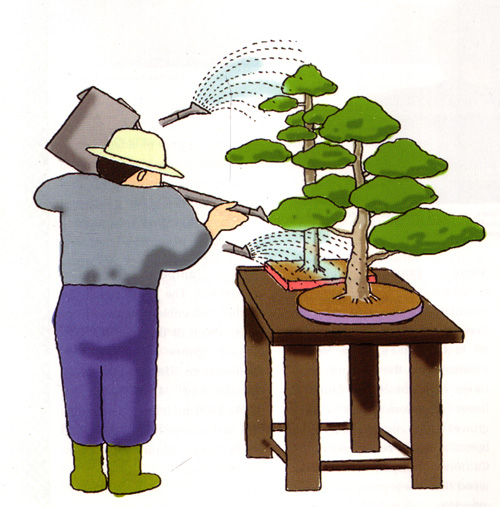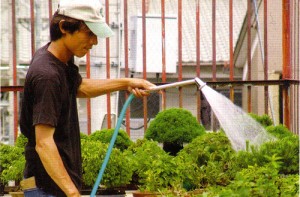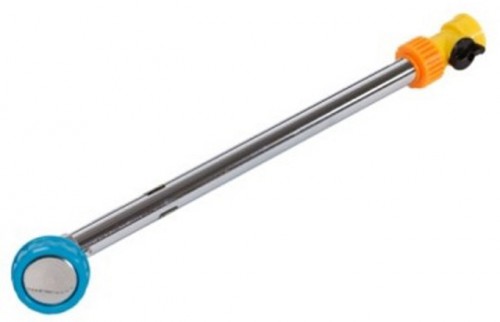 This drawing is from our Masters’ Series book; Junipers, Growing & Styling Juniper Bonsai.
This drawing is from our Masters’ Series book; Junipers, Growing & Styling Juniper Bonsai.
Our last couple posts have been about soil, so maybe it’s time to talk about watering. This will be the third time we’ve featured this post, but the time is right once again and, as it turns out, I’m on the road once again. A good time to dig into our archives.
The more you know about watering, the better.
Without timely, intelligent watering, any plant in a container is at risk. The more you know about watering, the better. BTW: A perfect complement to this post is a post about summer misting (hamisu) by Michael Hagedorn.

Photo from Shohin Bonsai by Morten Albek. Published by Stone Lantern.
Over the course of my thirty years working with bonsai the thing that most amazes me is how little most people know about watering (it has gotten better over the years, but still…). Brown thumbs abound.
One of the traits that people in the brown thumbed tribe share is a desire for easy answers. Don’t confuse me with valuable information, just tell me what to do. Or, in other words “how often do I water?” If this is your question, perhaps the best answer is: “how often do you drink a glass of water?”
Just a little plant science can go a long ways
Plants absorb most of their water and nutrients when the water content of the soil is around 20% to 50% of the available space. Available space is the space in the pot that is not taken up by solid matter. In other words, it is the space that can accommodate water and/or air. This space is found between soil particles and in pockets, holes and cracks within soil particles.
Skip this paragraph if you are easily confused:
Some sources use a percentage of total volume; if the soil takes 50% of the total volume and available space takes 50% (a pretty good ratio for bonsai soil), then you would say optimal water content is 10% to 25% percent of the total volume. This is the same as saying 20% to 50% of the available space.
If you water thoroughly, all the air is driven out of the available space. At that point the water content is 100% of the available space. If your soil drains properly, within a matter of moments, excess water will run out and the available space will contain a mixture of water and air.
Ideally, you want this mixture of water and air to quickly reach around 50% water and then slowly dry down to about 20% water. In other words, you want soil with excellent drainage and with good water retention at the optimal levels (this is a good place to tell you about our new Masters Bonsai Soil).
So, how often do you water?
How long soil holds water at optimal levels depends upon all kinds of things: your soil mix, size and type of pot, sun, heat, wind, temperature, time of year and health of the plant, to name a few. This goes back to the questions “how often do I water?” and “how often do you drink a glass of water?” You water when needed (when the soil is almost dry) and you drink when you’re thirsty.
Soak thoroughly when you water
In order to dispel all the old stale air and to assure the soil is thoroughly watered, make sure you soak the soil when you water.
Then wait until it’s almost dry to water again
To assure that the water/air mixture goes through the optimal range for water and nutrient retention, wait until the soil is almost dry before you water again (there are occasional exceptions, but that’s for another time).
Soil is key
So, for the two of you who have read this far, it should be clear that good soil is one of the keys to bonsai health. Without complicating matters by going into the numerous soils on the market, suffice it to say, if the soil you are using doesn’t allow for good drainage while providing some water retention at optimal levels, then it’s time to try a better soil (you might consider our new Masters Bonsai Soil).

Hey Wayne, have you read the description of “your” watering wand? Just checking ;-)
Hi Bruce,
Good eye. Busted again.
The inside story is: we never use Bonsai Trees in educational stuff (like Bark) but do use it in product descriptions. A little hypocrisy goes a long ways in this case: many many people search bonsai trees rather than just bonsai.
I notice (in the picture above) that he’s watering the plant as well as the soil which brings a question to mind. Should we mist between watering and if so how often? Also after total watering I run the water over the plant for a complete drenching then drain. Am I doing the right thing ?
Hi Chuck,
Just like rain is best way.
Complete drenching too. You don’t want any dry pockets in the soil.
The drain part is up to the soil. Good soil should drain off excess water almost immediately. All you have to do is wait until the soil is dry but not bone dry and then water again.
I understand the concept of only watering when the tree needs it (like we drink when we need to) and all my trees are potted in a free draining mix but I find it confusing when people talk about specific watering since if it rains the trees may get watered every day for weeks on end.
Hi Ann,
Yeah. Rain. If you have soil with excellent drainage (aka aeration) it shouldn’t be a problem.
The big issue in the West is that most people use soil with fine particles, too much organic material and other types of things that clog drainage. Then too much rain can be a problem.
When you trade poorly draining soil for soil like our Masters Bonsai Soil, then the risk shifts from overwatering to forgetting to water. Especially when it’s hot, or windy, or both.
There’s much more that can be, but enough for now.